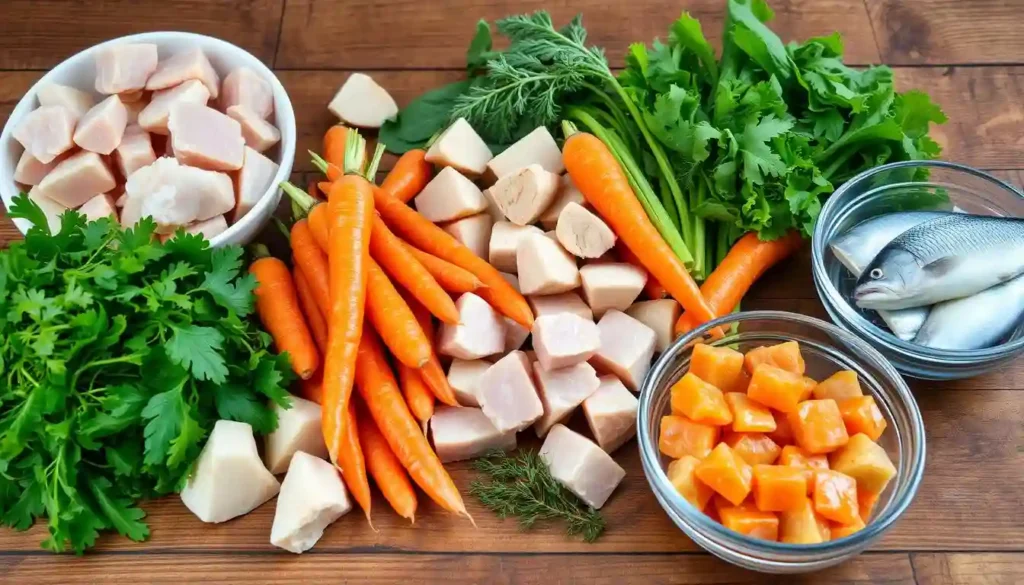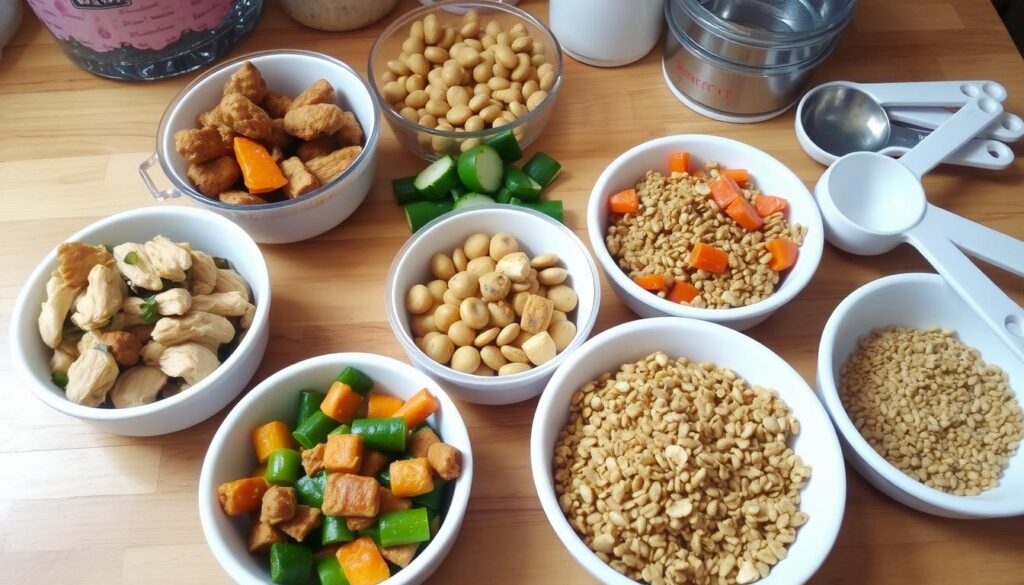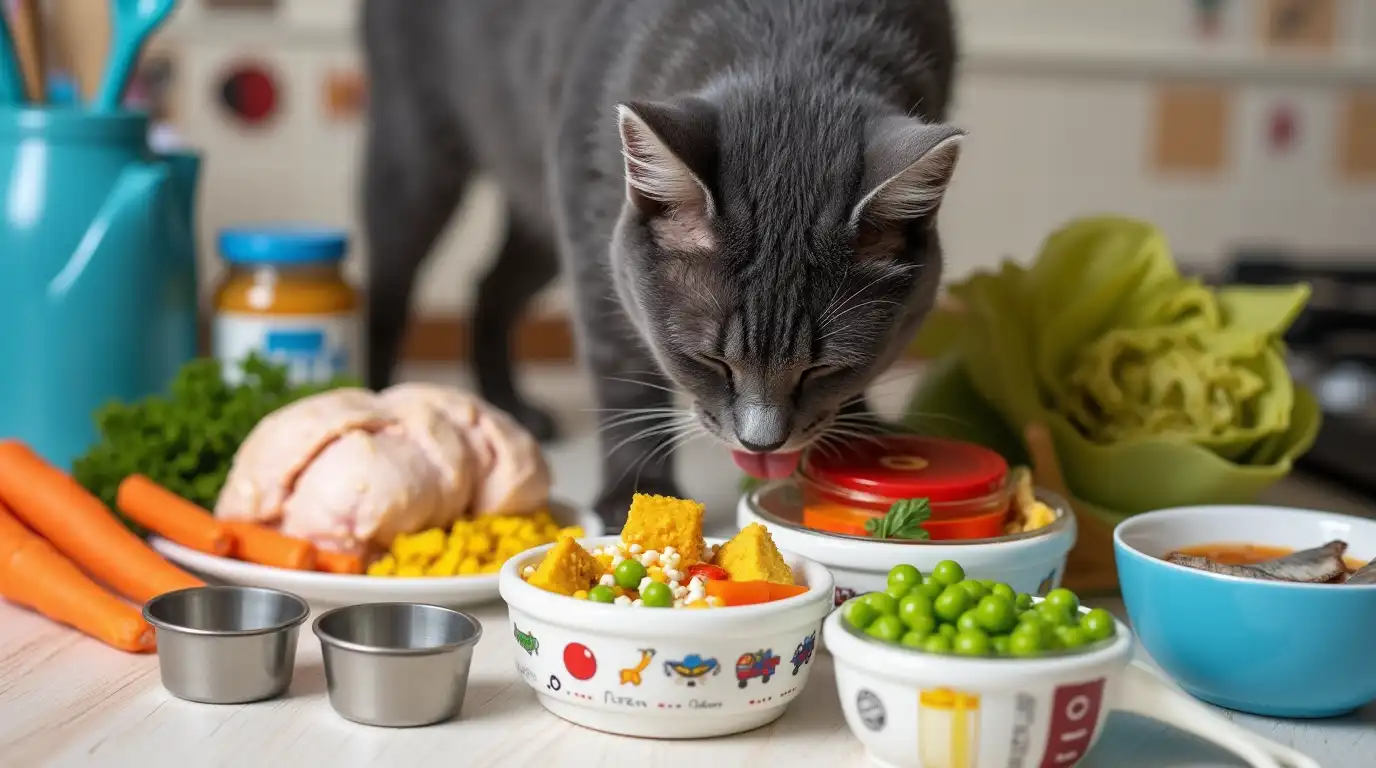Homemade Cat Food Recipes: Simple and Nutritious Options
Table of Contents
As a devoted cat parent, I know how special our bond with our feline friends is. Their health and happiness are top priorities. That’s why I’ve been thinking about making homemade cat food for a while.
It’s appealing to control my cat’s diet and meet their specific needs. Plus, it could save me money in the long run. If you’re also thinking about this, this guide on homemade cat food recipes is perfect for you.
The pet food market has grown a lot, with many options available. But more and more pet owners are making their own cat food at home. This is seen as a healthier and more personalized choice. This article will cover the basics of cat nutrition, share tasty and healthy recipes, and help you switch to homemade food for your cat.
Understanding Cat Nutrition Basics
Cats need a diet full of animal proteins to stay healthy. Knowing about essential nutrients, proteins, and vitamins is key. This knowledge helps in making homemade cat food.
Essential Nutrients for Feline Health
Cats need special amino acids like taurine and arginine. They also need certain fatty acids. These nutrients help keep organs working well, eyes healthy, and overall health good. A balanced diet is crucial for your cat’s health.
The Role of Proteins in Cat Diet
Proteins are vital for cats’ muscles, organs, and health. A diet rich in proteins supports an active lifestyle. It also helps with growth and development. Using high-quality animal proteins is essential in homemade cat food.
Important Vitamins and Minerals
Vitamins and minerals like calcium, vitamin A, and B-complex are key. They support the immune system, bone health, and energy. It’s important to focus on these nutrients in homemade cat food for your cat’s well-being.
| Nutrient | Function | Deficiency Symptoms |
|---|---|---|
| Taurine | Supports heart health, vision, and neurological function | Heart disease, blindness, and neurological issues |
| Iron | Plays a role in oxygen transport and red blood cell production | Anemia, weakness, lethargy, and potential collapse |
| Thiamine | Aids in energy metabolism and nervous system function | Decreased appetite, nausea, vomiting, and neurological issues |
| Choline | Supports liver function and fat metabolism | Liver problems, such as hepatic lipidosis |
| Vitamin E | Acts as an antioxidant and supports immune function | Pansteatitis, an inflammatory condition of body fat |
Knowing about cat nutrition and feline health helps in making homemade cat food. This ensures your cat gets a balanced and nutritious diet.
Benefits of Making Cat Food at Home
Preparing homemade cat food at home has many benefits for you and your cat. You can choose the ingredients to make sure your cat eats well. This is great for cats with food allergies or health problems, as you can avoid bad additives in store-bought cat food.
One big plus of making cat food at home is you can meet your cat’s dietary needs. Homemade cat food lets you pick the best ingredients. This means your cat gets the nutrients they need for better health and happiness.
Also, making cat food at home might save you money. Using fresh ingredients and cutting down on packaging can be cheaper. This way, you can give your cat a tasty and healthy meal without spending a lot.
But, it’s key to make sure your homemade cat food is complete and balanced. “Only one out of hundreds of homemade cat food diets analyzed over the years has come close to being complete and balanced.” Talking to a vet nutritionist can help you make a recipe that’s right for your cat.
In short, making cat food at home has many advantages. You can pick the best ingredients, meet your cat’s needs, save money, and give them a personalized meal. By knowing what cats need, you can make sure your homemade cat food is the best for your furry friend.
Required Kitchen Tools and Equipment
To make healthy homemade cat food, you need a well-stocked kitchen. You’ll need certain appliances and supplies for easy preparation and safe storage.
Essential Appliances
A food processor or blender is key for mixing ingredients well. A meat grinder helps with grinding raw meats. Also, a kitchen scale is vital for measuring the right amounts, making sure your cat gets what they need.
Storage Containers and Supplies
For storing homemade cat food, you’ll need airtight containers and freezer-safe bags. Reusable containers like BPA-free plastic or glass jars keep food fresh. Ice cube trays make it easy to freeze and serve individual portions.
Other tools like measuring cups and spoons, a digital food thermometer, and a sharp knife and cutting board are also useful. They help in preparing and cooking the food.
Having the right tools ensures your cat’s meals are made efficiently, stored safely, and meet their nutritional needs.
| Essential Equipment for Homemade Cat Food | Purpose |
|---|---|
| Food Processor or Blender | Blending and mixing ingredients |
| Meat Grinder | Grinding raw meats |
| Kitchen Scale | Measuring precise portions |
| Airtight Containers and Freezer Bags | Storing homemade cat food |
| Ice Cube Trays | Portioning and freezing individual servings |
| Measuring Cups and Spoons | Accurate ingredient measurements |
| Digital Food Thermometer | Monitoring cooking temperatures |
| Sharp Knife and Cutting Board | Food preparation |
Choosing Quality Ingredients for Cat Food
When making homemade cat food, the ingredients you choose are key. Pick fresh, human-grade meats like chicken, turkey, beef, and fish. These are rich in protein, which helps with muscle growth and health.
Organ meats like liver and heart are also great. They’re packed with vitamins A, B, and iron. Adding these to your cat food recipes makes meals more nutritious.
Stay away from harmful foods like onions, garlic, and some herbs. They can make cats very sick. Also, add a cat-specific vitamin and mineral blend to your food. This ensures your cat gets all the nutrients they need.
| Ingredient | Benefit |
|---|---|
| Chicken, Turkey, Beef, Fish | High-quality protein sources for muscle development and overall health |
| Organ Meats (Liver, Heart) | Excellent sources of vitamins A, B, and iron |
| Cat-Specific Vitamin and Mineral Supplements | Ensures a balanced and complete diet |
| Avoidance of Onions, Garlic, Certain Herbs | Eliminates toxic ingredients that can harm cats |
By picking the right cat food ingredients and adding important vitamins and minerals, you can make a tasty and healthy meal for your cat.
Homemade Cat Food Recipes
As a cat owner, you can control your cat’s diet with homemade food. These meals are fresh and can be made to fit your cat’s needs. Here are some easy and healthy recipes that your cat will love.
Basic Chicken Recipe
This recipe is simple but packed with protein. Mix 2 lbs of ground chicken, 1/2 cup of chicken liver, 1 cup of water, 2 eggs, and 1/2 tsp of eggshell powder. Remember to add supplements for a balanced diet.
Salmon Delight
Does your cat enjoy seafood? This Salmon Delight recipe is perfect. It combines 2 cups of cooked salmon, 2 tbsp of steamed broccoli, 2 tbsp of fish oil, and 2 boiled eggs for a tasty meal.
Turkey and Rice Blend
For a more filling meal, try the Turkey and Rice Blend. It includes 1/2 lb of turkey giblets, 1/2 cup of brown rice, 1/4 cup of carrot, 1/2 cup of spinach, and supplements for a complete diet.
Adjust the recipe based on your cat’s needs. Homemade cat food is a great way to give your cat a healthy, flavorful diet.
Raw Food Diet Options
Many cat owners are now looking into raw food diets for their pets. These diets include uncooked meat, organs, and bones. They promise better digestion, dental health, and a shinier coat for your raw cat food friend.
Here’s a recipe for a healthy homemade raw cat food:
- 737g boneless protein (such as chicken, turkey, or beef)
- 85g heart
- 45g liver
- 45g kidney
- Eggshell powder
- Salmon oil
- Vitamin supplements
- Egg yolk
Before starting a raw diet, talk to your vet. They can help ensure it’s safe for your cat. Make sure to wash everything well and store the ingredients correctly.
“A raw diet can provide cats with the optimal nutrition they need, but it’s crucial to do it safely and under the guidance of a veterinarian.”
Adding raw food to your cat’s diet can be a natural way to improve their health. Always keep your cat’s safety and health in mind when trying new foods.

Cooked vs Raw: Making the Right Choice
Choosing between cooked and raw cat food can be tough. Both have good points and downsides. Knowing these can help you pick the best for your cat.
Pros and Cons of Each Method
Cooked cat food is safer and simpler to make. Cooking kills bacteria, making it safer. But, it might lose some nutrients because of the heat.
Raw cat food, on the other hand, keeps more natural nutrients. It doesn’t cook, so vitamins and minerals stay better. But, it needs careful handling to avoid safety issues.
Safety Considerations
With cooked cat food, make sure it’s cooked right to kill bacteria. Bad cooking can make your cat sick.
Raw cat food diets have risks like Salmonella and E. coli. Keeping food clean and stored right is key. Cats with weak immune systems are at higher risk.
Choosing between cooked and raw depends on your cat’s health, your comfort with food, and your vet’s advice. Weighing the good and bad of each can help you decide best for your cat.
Essential Supplements and Additives
When making homemade cat food, it’s important to give your cat all the nutrients they need. A good diet from quality ingredients is the base. But, adding key supplements can make your cat’s meals even better. Let’s look at the main supplements and additives for your homemade cat food.
Taurine is a must for cats, with 250-500 mg daily recommended. It helps with heart health, vision, and brain function. Calcium, from bone meal or eggshells, is also key, as cats need 0.8-1.0% calcium in their diet.
A vitamin B complex is good too, helping with energy and body functions. Fish oil adds omega-3 fatty acids, which fight inflammation and keep the coat healthy.
| Supplement | Recommended Amount | Benefits |
|---|---|---|
| Taurine | 250-500 mg daily | Supports heart health, vision, and neurological function |
| Calcium | 0.8-1.0% of diet | Promotes strong bones and teeth |
| Vitamin B Complex | Varies by product | Supports energy metabolism and overall health |
| Fish Oil | Varies by product | Provides omega-3 fatty acids for reduced inflammation and a healthy coat |
The right supplements and amounts depend on your cat food recipe and your cat’s needs. Always talk to your vet to make sure your cat gets the right supplements for their health.
“Proper supplementation is key to ensuring your homemade cat food provides a complete and balanced diet for your feline companion.”
Adding these essential supplements and additives to your homemade cat food recipes ensures your cat gets all the nutrients they need. Always check with your vet and watch your cat’s health to make the best choices for their diet.
Portion Control and Storage Guidelines
Getting the right cat food portions is key for your cat’s health. The amount depends on your cat’s weight, age, and how active they are. A good rule is to feed 2-4% of their body weight each day, in several meals.
For homemade cat food storage, keep it cool. Store parts in the fridge for 2-3 days. Freeze the rest in airtight containers or bags. To thaw, just put it in the fridge overnight. Always serve at room temperature for the best taste and nutrition.
Proper Serving Sizes
- Feed your cat 2-4% of their body weight per day, divided into multiple meals.
- Adjust portion sizes based on your cat’s age, activity level, and individual needs.
- Consult with your veterinarian to determine the ideal serving size for your feline friend.
Storage Best Practices
- Refrigerate portions for up to 2-3 days.
- Freeze the remaining homemade cat food in airtight containers or freezer bags.
- Thaw frozen portions in the refrigerator overnight before serving.
- Always serve homemade cat food at room temperature for optimal palatability and nutrient retention.

By following these cat food portions and homemade cat food storage tips, you can make sure your cat gets the right food. This way, they’ll enjoy a diet made just for them.
Common Mistakes to Avoid
Making homemade cat food can be rewarding and healthy for your cat. But, it’s important to avoid mistakes that can harm your pet’s health. Cats need animal-based proteins and essential nutrients for their well-being.
One big mistake is not balancing the nutrients in your cat’s food. Cats have specific needs, and not meeting these can cause serious health problems. Another mistake is overfeeding, as obesity is the most common nutritional disease in cats.
Using unsafe ingredients is another error to avoid. Foods like onions, garlic, grapes, raisins, and chocolate are toxic to cats. Also, not using organ meats can lead to nutritional deficiencies, as cats need a variety of proteins.
It’s key to talk to a vet before making homemade cat food. They can help ensure your cat gets the right nutrients. They can guide you on the calcium to phosphorus ratio and taurine for heart health.
Also, introduce new foods slowly to avoid digestive issues. Sudden diet changes can upset your cat’s stomach. So, it’s best to gradually introduce new recipes.
By avoiding these mistakes and working with your vet, you can make healthy meals for your cat. This will keep your feline friend happy and healthy.
| Mistake | Explanation |
|---|---|
| Nutrient Imbalance | Failing to properly balance the essential vitamins, minerals, and macronutrients in homemade cat food can lead to health issues. |
| Overfeeding | Providing too many calories can contribute to obesity, the most common nutritional disease in cats. |
| Unsafe Ingredients | Incorporating toxic foods like onions, garlic, grapes, raisins, and chocolate can be harmful to cats. |
| Lack of Variety | Relying solely on muscle meat without including organ meats can result in nutritional deficiencies. |
| Abrupt Diet Changes | Transitioning to homemade cat food too quickly can cause digestive upset; gradual introduction is recommended. |
Special Dietary Considerations for Cats with Health Issues
When caring for cats with health issues, making their food special can help a lot. Cats with kidney disease, diabetes, or food sensitivities need special care. Changing their homemade food can help manage their health and keep them happy.
Addressing Kidney Disease
Cats with kidney disease need less phosphorus and sodium. Use chicken or turkey instead of high-sodium foods. Talk to your vet to find the right diet for your cat.
Managing Diabetes
Cats with diabetes do well on low-carb, high-protein diets. Use lean meats, eggs, and little grains in their food. This helps keep their blood sugar in check.
Addressing Food Sensitivities
For cats with food sensitivities, try new proteins like rabbit or venison. Avoid common allergens like beef, dairy, and wheat. Your vet can help find the right diet for your cat.
Supporting Senior Cats
Senior cats need special care in their diet. They do well with easy-to-digest proteins and omega-3 fatty acids. Use high-quality proteins and fish oil in their food.
Always talk to a vet before changing your cat’s diet. They can guide you on the best food and amounts for your cat’s health.
Conclusion
Homemade cat food is a great way to make sure your cat eats well. It lets you know exactly what your cat needs and how they like it. This way, you can give them a diet that’s just right for them.
But, making cat food at home needs careful attention. You must make sure it’s balanced and safe for your cat. Always talk to a vet to make sure your cat’s diet is good for them.
Choosing between cooked or raw food is important. The main thing is to keep your cat safe and healthy. With the right knowledge, homemade cat food can be a great choice for you and your cat.
FAQ
What are the essential nutrients cats need in their diet?
Cats need a diet rich in animal proteins because they are obligate carnivores. They require taurine, arginine, and specific fatty acids. Proteins help keep their muscles and organs healthy.
Vitamins and minerals like calcium, vitamin A, and B-complex vitamins are also important. They help with various bodily functions.
What are the benefits of making cat food at home?
Homemade cat food lets you control the quality of ingredients. It can be tailored to your cat’s specific needs or preferences. It might also save you money.
It’s especially good for cats with food sensitivities or health issues. You can avoid artificial preservatives and fillers found in commercial foods.
What kitchen tools and equipment are needed for making homemade cat food?
You’ll need a food processor or blender, a meat grinder, and measuring cups and spoons. A kitchen scale is also essential. For storing, use airtight containers, freezer-safe bags, and ice cube trays.
Having the right tools makes preparing and storing homemade cat food easier and safer.
What ingredients should be used for homemade cat food?
Choose high-quality, fresh, human-grade meats like chicken, turkey, beef, and fish. Organ meats like liver and heart are great sources of nutrients. Avoid onions, garlic, and certain herbs because they’re toxic to cats.
Use cat-specific vitamin and mineral blends to ensure a balanced diet.
Can I make raw food diets for my cat at home?
Yes, raw diets include uncooked meat, organs, and bones. They may improve digestion, dental health, and coat condition. A sample recipe includes boneless protein, heart, liver, kidney, eggshell powder, salmon oil, vitamin supplements, and egg yolk.
Always talk to a vet before starting a raw diet and follow food safety guidelines.
What supplements do I need to add to my homemade cat food?
Essential supplements include taurine (250-500 mg daily), calcium, vitamin B complex, and fish oil for omega-3 fatty acids. Cats need 0.8-1.0% calcium in their diet. Use low-sodium salt to provide iodine.
Specific supplements may vary based on the recipe and your cat’s needs. Always consult with a vet for proper supplementation.
How do I determine the proper portion sizes for my cat?
Proper portion sizes depend on your cat’s weight, age, and activity level. Aim for 2-4% of body weight daily. Divide into multiple meals.
For storage, refrigerate portions for 2-3 days and freeze the rest. Use airtight containers or freezer bags. Thaw frozen portions in the fridge overnight. Always serve food at room temperature.
What are some common mistakes to avoid when making homemade cat food?
Common mistakes include not balancing nutrients properly, overfeeding, using unsafe ingredients, and not consulting a vet. Avoid excessive liver to prevent vitamin A toxicity.
Don’t rely solely on muscle meat without organ meats. Ensure the right calcium to phosphorus ratio. Don’t substitute ingredients without understanding their nutritional impact. Always introduce new foods gradually to prevent digestive upset.
How can I adjust homemade cat food for cats with health issues?
Cats with health issues may need specialized diets. For kidney disease, reduce phosphorus and sodium. For diabetes, focus on low-carbohydrate, high-protein diets.
Cats with food sensitivities may benefit from novel protein sources like rabbit. Senior cats may need easily digestible proteins and increased omega-3 fatty acids. Always consult with a vet to tailor diets for specific health conditions.
Tried This Recipe? Leave Your Review!
There are no reviews yet. Be the first one to write one.

